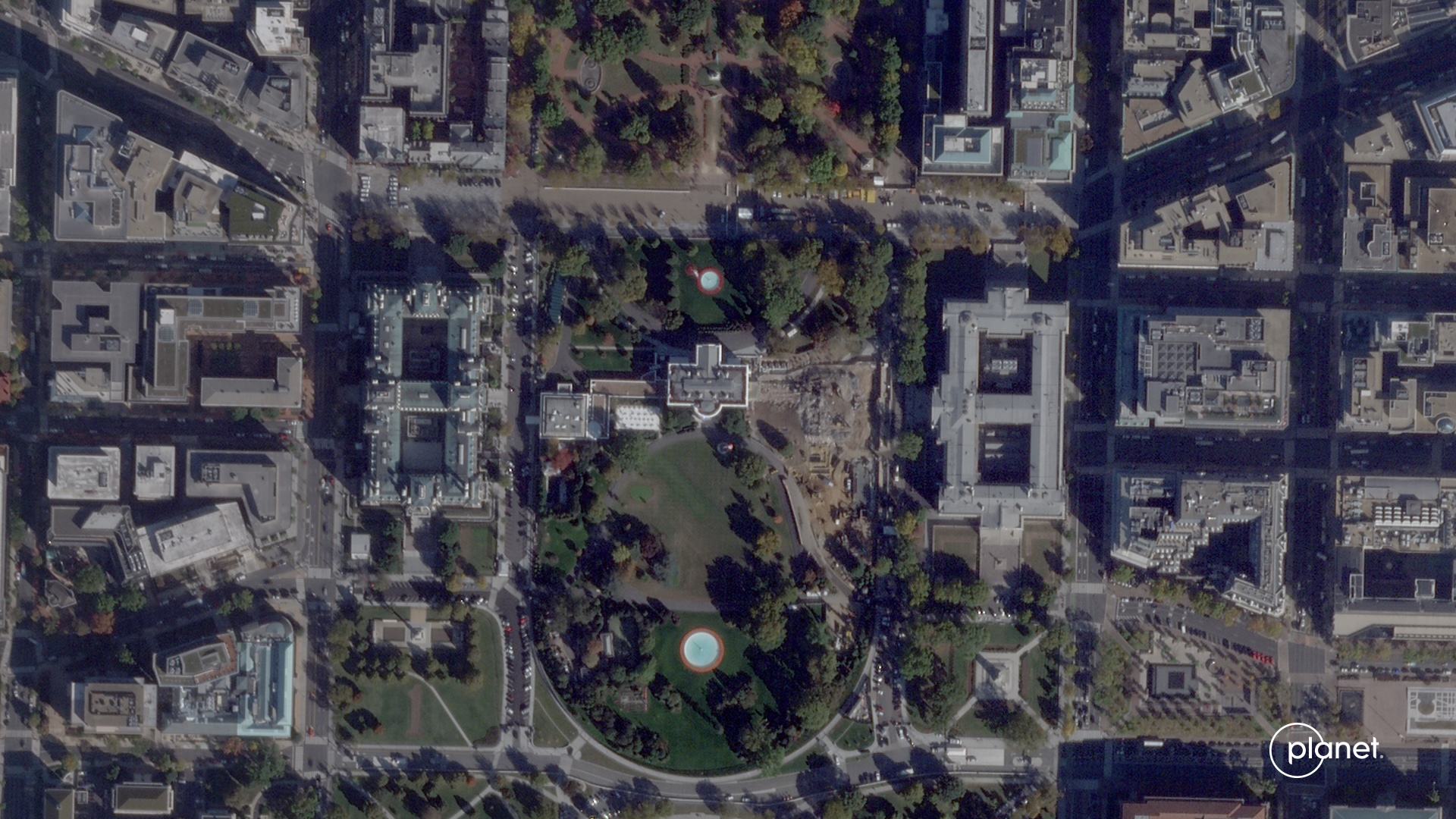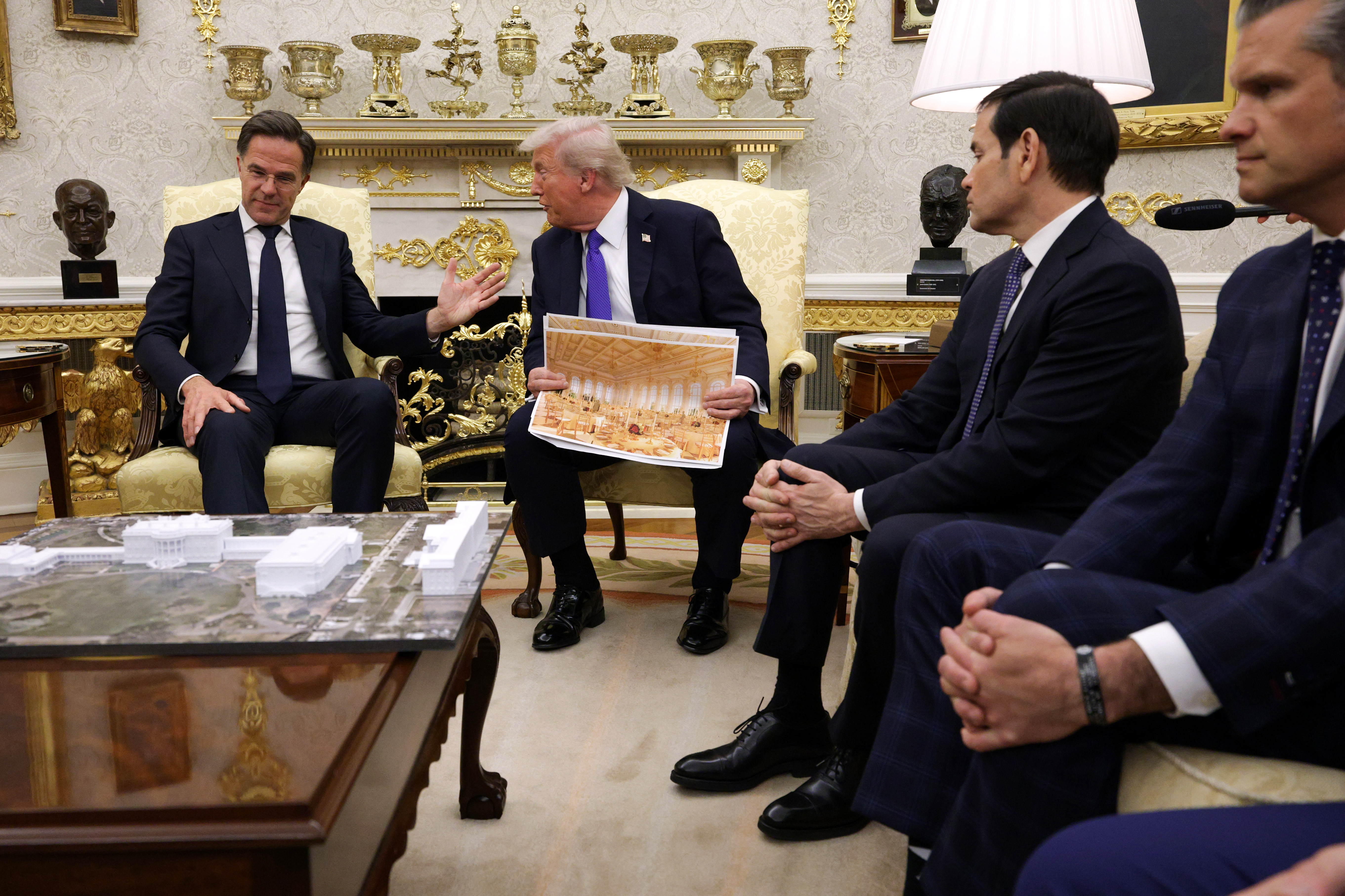“Now it looks like the White House is physically being destroyed.”
The facade of the East Wing of the White House is demolished by work crews on October 22, 2025. Credit: Andrew Harnik/Getty Images
You need to go up—way up—to fully appreciate the changes underway at the White House this week.
Demolition crews starting tearing down the East Wing of the presidential mansion Tuesday to clear room for the construction of a new $300 million, 90,000-square-foot ballroom, a recent priority of President Donald Trump. The teardown drew criticism and surprise from Democratic lawmakers, former White House staffers, and members of the public.
It was, after all, just three months ago that President Donald Trump defended his ballroom plan by saying it wouldn’t affect the existing structure at the White House. “It won’t interfere with the current building,” he said in July. “It’ll be near it but not touching it—and pays total respect to the existing building, which I’m the biggest fan of.”
So it shocked a lot of people when workers took a wrecking ball to the East Wing. Sen. Lisa Murkowski (R-Alaska) told reporters Thursday that the “optics are bad” as the Trump administration demolishes part of the White House, especially during a government shutdown.
“People are saying, ‘Oh, the government’s being destroyed,’” she said. “Well, now it looks like the White House is physically being destroyed.”
The US Secret Service on Thursday closed access to the Ellipse, a public park overlooking the South Lawn of the White House. Journalists were capturing “live images” of the East Wing destruction from the Ellipse before the Secret Service ushered them out of the park, according to CNN’s Jim Sciutto. Employees at the Treasury Building, just across the street from the East Wing, were instructed not to share photos of the demolition work, The Wall Street Journal reported.
Some Trump supporters used their social media accounts to push back against the outcry, claiming only a small section of the East Wing’s facade would be torn down. An image taken from space revealed the reality Thursday.
Eyes always above
Without press access to see the demolition firsthand, it fell to a camera hundreds of miles above the White House to see what was really happening at the East Wing. Planet Labs released an image taken Thursday morning from one of its SkySat satellites showing the 123-year-old annex leveled.

This image taken Thursday from a SkySat Earth observation satellite shows that the East Wing of the White House is gone. Credit: Planet Labs PBC
What became known as the East Wing was first constructed in 1902 and was then rebuilt in 1942 during the Franklin Roosevelt administration to create more office space and provide cover for a bunker during World War II. In modern presidencies, the East Wing was typically home to the first lady’s staff.
Planet Labs, based in San Francisco, operates a fleet of hundreds of small Earth-imaging satellites mapping the planet every day. The company sells its imagery to commercial customers and the US government, including intelligence agencies, which use the imagery to augment the surveillance capabilities of more exquisite government-owned spy satellites.
Users often turn to satellite imagery from companies like Planet Labs to find out what’s going on in war zones, countries ruled by authoritarian regimes, or in the aftermath of a natural disaster. Satellite constellations like Planet Labs scan for changes across the globe every day, making it virtually impossible to hide a large construction project.
The SkySat satellite used for Thursday’s examination of the White House flies at an altitude of approximately 295 miles (475 kilometers). It can capture imagery with a resolution of about 20 inches (50 centimeters) per pixel. Planet Labs owns 15 SkySats, each with three overlapping 5.5-megapixel imaging sensors fitted under a downward-facing 14-inch-diameter (35-centimeter) telescope, according to the company.
Who’s paying?
It turns out some of Planet Labs’ cohorts among the government’s cadre of defense and aerospace contractors are actually funding the construction of the new White House ballroom. Lockheed Martin, the Pentagon’s largest defense contractor, is on the list of donors released by the White House. At least two other companies with business relating to defense and aerospace were also on the list: Booz Allen Hamilton and Palantir Technologies.
Palantir has invested in BlackSky, one of Planet’s competitors in the commercial remote sensing market.

People watch along a fence line Thursday as crews demolish the East Wing of the White House. Credit: Brendan Smialowski/AFP via Getty Images)
The Trump administration has said no public money will go toward the new ballroom, but officials haven’t said how much each donor is contributing. Many donors have business dealings with the federal government, raising ethical concerns that those paying for the ballroom might win favor in future contract decisions.
Trump said he will also contribute an undisclosed sum for the ballroom.
Regardless of whether the donors are buying influence, they are funding the most significant overhaul of the White House grounds since former President Harry Truman renovated the mansion’s interior and added a balcony to the South Portico. The Truman-era changes were approved by Congress, which established a commission to oversee the work. There’s been no such oversight from Congress this time.
The new ballroom will be nearly twice the size of the most iconic element of the White House grounds: the two-century-old executive residence.
“It’s going to turn the executive mansion into an annex to the party space,” said Edward Lengel, who served as chief historian of the White House Historical Association during Trump’s first term. “I think all the founders would have been disgusted by this,” he told CNN.
Karoline Leavitt, the White House press secretary, shared a different point of view in an interview with Fox News earlier this week.
“I believe there’s a lot of fake outrage right now because nearly every single president who has lived in this beautiful White House behind me has made modernizations and renovations of their own,” Leavitt said.
An official White House fact sheet published Tuesday used similar sensationalized language, accusing “unhinged leftists and their Fake News allies” of “clutching their pearls over President Donald J. Trump’s visionary addition of a grand, privately-funded ballroom to the White House.”

President Donald Trump displays a rendering of the White House ballroom as he meets with NATO Secretary General Mark Rutte (left) in the Oval Office of the White House on Wednesday. Credit: Alex Wong/Getty Images
It’s true that every president has put their own mark on the White House, but all of the updates cost at least an order of magnitude less than Trump’s ballroom. Most amounted to little more than redecorating, and none were as destructive as this week’s teardown. Former President Barack Obama repainted the lines of the White House tennis court and installed hoops to turn it into a basketball court. During the George W. Bush administration, the White House press briefing room got a significant makeover. Taxpayers and media companies shared the bill. It’s hard to imagine that happening today.
Former President Gerald Ford had an outdoor swimming pool built near the West Wing. Former First Lady Jacqueline Kennedy famously spearheaded the redesign of the White House Rose Garden and East Garden, which was later renamed in her honor. The grass in the Rose Garden was paved over with stone tiles earlier this year, and the Jacqueline Kennedy Garden was razed this week, the result of which was also visible from space.
In July, Leavitt said the East Wing would be “modernized.” Like Trump, she did not mention plans for demolition, only saying: “The necessary construction will take place.”
Thanks to satellites and commercial space, we now know what necessary construction really meant.
